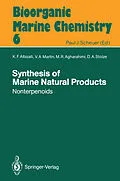Volumes five and six of Bioorganic Marine Chemistry differ from their predecessors in two respects - they deal exclusively with laboratory synthesis of marine natural products and they represent the effort of a single author and his associates. The rationale for these departures is readily perceived. For several decades organic synthesis has without doubt been the most spectacular branch of organic chemistry. While the late R.B. Woodward's dictum - organic compounds can undergo only four basic reactions: they can gain electrons; they can lose electrons; they can be transformed with acid or with base - is still true, the wealth and variety of available reagents which will accomplish chemical transformations has reached staggering proportions. Little wonder then, that synthetic methodology has achieved a high degree of predictability and total synthesis of natural products has been successfully directed toward ever more challenging targets. As for the second point, that of single authorship, multiple authorship would invariably have led to gaps and overlaps, thus making it difficult to assemble and assess recent research in a systematic and comprehens ive fashion.
Inhalt
3 Amino Acids and Peptides.- 3.1 Various Amino Acids.- 3.1.1 Carnosadine.- 3.1.2 Ovothiols A and C.- 3.1.3 (alpha)-Kainic Acid and allo-Kainic Acid.- 3.1.4 Domoic Acid.- 3.1.5 Tetraacetylclionamide.- 3.1.6 Demethyldysidenin and Demethylisodysidenin.- 3.2 Brominated Tyrosine Derivatives.- 3.2.1 Quinols.- 3.2.2 Aplysinadiene.- 3.2.3 Aerothionin, Homoaerothionin and Aerophobin-1.- 3.2.4 Bastadins -1, -2, -3, and -6.- 3.3 Peptides.- 3.3.1 Didemnins.- 3.3.2 Jaspamide.- 3.3.3 Geodiamolides A and B.- 3.3.4 Thiazole-containing Peptides.- 3.3.4.1 Patellamides A, B and C.- 3.3.4.2 Ulicyclamide and Ulithiacyclamide.- 3.3.4.3 Ascidiacyclamide and Dolastatin-3.- 3.3.5 Dolastatin-10 and Hexaacetylcelenamide.- 3.3.6 Teleocidin A-l (Lyngbyatoxin A) and Teleocidin A-2.- 4 Fatty Acid Derived Metabolites.- 4.1 Haloethers of Laurencia sp.- 4.1.1 Laurencenyne.- 4.1.2 Laurediol.- 4.1.3 Laurediol Derivatives.- 4.1.4 Laurencin.- 4.1.5 Laurenyne.- 4.1.6 cis-Maneonenes A and B.- 4.1.7 trans-Maneonene B.- 4.1.2 Panacene.- 4.2 Prostanoids.- 4.2.1 Clavulones.- 4.2.1.1 Clavulones I and II.- 4.2.1.2 Clavulone III.- 4.2.1.3 Desacetylclavulone II.- 4.2.1.4 Chlorovulone II.- 4.2.1.5 Preclavulone A.- 4.2.2 Punaglandins.- 4.2.2.1 Punaglandin 4.- 4.2.2.2 Punaglandin 3 and (7E)- Punaglandin-4.- 4.2.3 Hybridalactone.- 4.3 C8-C11 Algal Pheromones.- 4.3.1 Dictyoprolene.- 4.3.2 Dictyopterenes.- 4.3.2.1 Dictyopterene A.- 4.3.2.2 Dictyopterene B (Hormosirene).- 4.3.2.3 Dictyopterene C and Dictyopterene C".- 4.3.2.4 Dictyopterene D' (Sirenin, Ectocarpene).- 4.3.2.5 4-n-Butyl-2,6-Cycloheptadienone.- 4.3.2.6 Multifidene.- 4.3.2.7 Desmarestene and Viridiene.- 4.3.2.8 Lamoxirene.- 4.3.2.9 Aucantene.- 4.3.2.10 Fucoserratene.- 4.3.2.11 Giffordene.- 4.3.2.12 Clavularins A and B.- 4.4 Miscellaneous Metabolites.- 4.4.1 Acarnidines.- 4.4.2 Pahutoxin.- 4.4.3 D-erythro-1 -Desoxydihydroceramide-1-Sulfonic Acid.- 4.4.4 Phosponosphingoglycolipid from Turbo cornutus.- 4.4.5 Metabolites of Plexaura flava.- 4.4.6 Notheia anomala Metabolite.- 4.4.7 Octacosadienoic Acids.- 4.4.8 Hexacosadienoic Acids.- 4.4.9 Diacetylenes from Reniera fulva.- 5 Nitrogenous Metabolites.- 5.1 Indoles and Related Compounds.- 5.1.1 Flustramine B.- 5.1.2 Surugatoxins.- 5.1.3 Various indoles.- 5.1.3.1 Trikentrins.- 5.1.3.2 Indoles Related to Aplysinopsin.- 5.1.3.3 Dendrodoine.- 5.1.3.4 Tetrahalogenoindoles.- 5.1.3.5 (E)-3-(6-Bromoindole-3-yl)Prop-2-enoate.- 5.2 Carbazoles.- 5.2.1 Hyellazole and 6-Chlorohyellazole.- 5.2.2 Eudistomins.- 5.2.2.1 EudistominA.- 5.2.2.2 Eudistomins H, I, P.- 5.2.2.3 Other Eudistomins.- 5.2.3 Manzamine C.- 5.3 Pyridines.- 5.3.1 Navenone A.- 5.3.2 Pulo'upone.- 5.3.3 Ascididemin.- 5.3.4 Aaptamine and Demethoxyaaptamine.- 5.3.5 Amphimedine.- 5.4 Guanidine-Containing and related Metabolites.- 5.4.1 Tetrodotoxin.- 5.4.2 Saxitoxin.- 5.4.3 Ptilocaulin.- 5.4.4 Oroidin.- 5.4.5 Dibromophakellin.- 5.4.6 Girolline.- 5.5 Nucleosides and Related Substances.- 5.5.1 Mycalisin.- 5.5.2 Phidolopin.- 5.5.3 6-Imino-l,9-dimethyl-8-oxopurine.- 5.5.4 1-Methylisoguanosine (Doridosine).- 5.6 Reniera Alkaloids.- 5.6.1 Mimosamycin.- 5.6.2 Reniera Isoindole.- 5.6.3 7-Methoxy-1,6-dimethyl-5,8-Dihydroisoquinoline-5,8-dione and N-Formyl-1,2- dihydrorenierone.- 5.6.4 Renierone.- 5.7 Zoanthoxanthins.- 5.8 Pyrrole-Containing Alkaloids.- 5.8.1 Oscarella lobularis Pyrrole Metabolite.- 5.8.2 5-Nonylpyrrole-2-Carbaldehyde.- 5.8.3 Pentabromopseudilin.- 5.8.4 Bonellin, Methyl Ester.- 6 Miscellaneous Metabolites.- 6.1 Metabolites Related to Citric Acid.- 6.1.1 Delesserine.- 6.1.2 Leptosphaerin.- 6.2 Brominated Phenolic Esters.- 6.3 Others.- 6.3.1 Metabolites of Delisia fimbriata.- 6.3.2 Kjellmanianone.- 6.3.3 Pukeleimide A.- 6.3.4 Latrunculin B.- 6.3.5 Bisucaberin.- 6.3.6 Hormothamnione.- 6.3.7 Bissetone.- 6.3.8 (S,S)-Palythazine.- 6.3.9 Dysidin.- 6.3.10 Grateloupia filicina Metabolite and Related Compounds.- 6.3.11 Didemnenones A and B.- 6.3.12 Tridacna maxima Metabolite.- 6.3.13 Nereistoxin.- 6.3.14 3-n-Hexyl-4,5-dithiacycloheptan-5-one.- 6.3.15 3-Methylnavenone B.- 6.3.16 Malyngolide.- 6.3.17 Okadaic Acid.- 6.3.18 Debromoaplysiatoxin.- 7 Summary.- 8 References.
